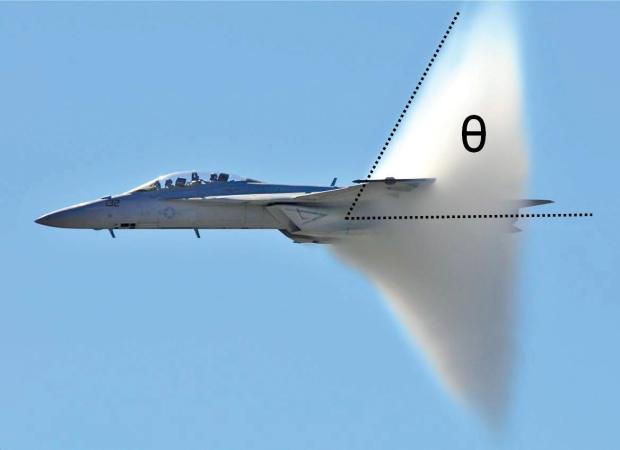When an object moves faster than the speed of sound, it will go past an observer before the sound waves emitted by object do. The waves are compressed so strongly that a shock front forms. So instead of the sound gradually building up to a maximum as it is usually the case, the observer will hear nothing until the shock front arrives with a sudden and explosion-like noise.
Geometrically, the shock front forms a cone around the object, which under certain circumstances can even be visible to the naked eye (see image below). The great formula that is featured in this section deals with the opening angle of said cone. This angle, symbolized by the Greek letter θ, is also indicated in the image.
All we need to compute the mach angle θ is the velocity of the object v (in m/s) and speed of sound c (in m/s):
sin θ = c / v
Let’s turn to an example.
———————-
A jet fighter flies with a speed of v = 500 m/s toward its destination. It flies close to the ground, so the speed of sound is approximately c = 340 m/s. This leads to:
sin θ = 340 / 500 = 0.68
θ = arcsin(0.68) ≈ 43°
———————-
In the picture above the angle is approximately 62°. How fast was the jet going at the time when the picture was taken? We’ll set the speed of sound to c = 340 m/s and insert all the given data into the formula:
sin 62° = 340 / v
0.88 = 340 / v
Obviously we need to solve for v. To do that, we first multiply both sides by v. This leads to:
0.88 · v = 340
Dividing both sides by 0.88 results in the answer:
v = 340 / 0.88 ≈ 385 m/s ≈ 1390 km/h ≈ 860 mph
———————-
This was an excerpt from the ebook “Great Formulas Explained – Physics, Mathematics, Economics”, released yesterday and available here: http://www.amazon.com/dp/B00G807Y00.


Your posts give some very useful information, thank you. (I really enjoyed listening to your music too).
Best wishes, Jennifer